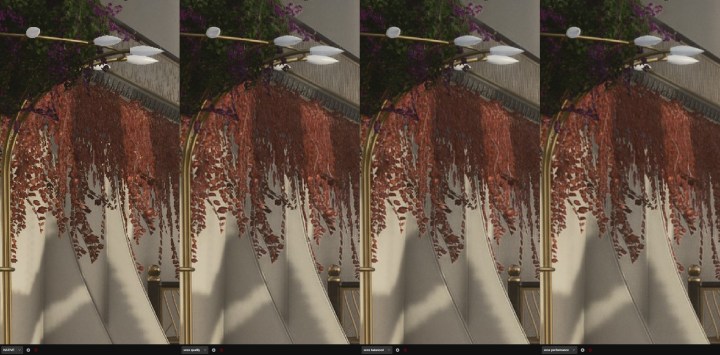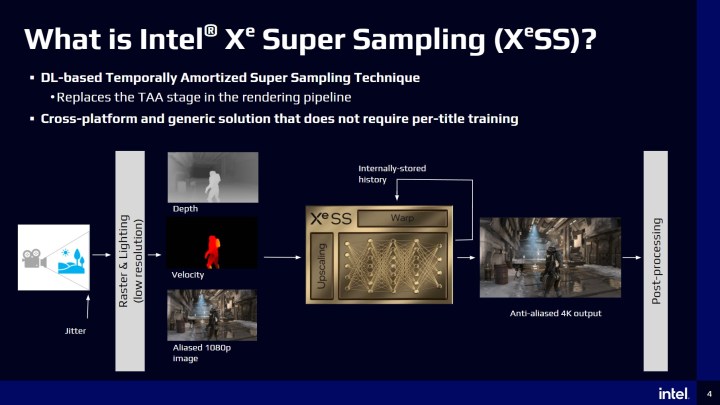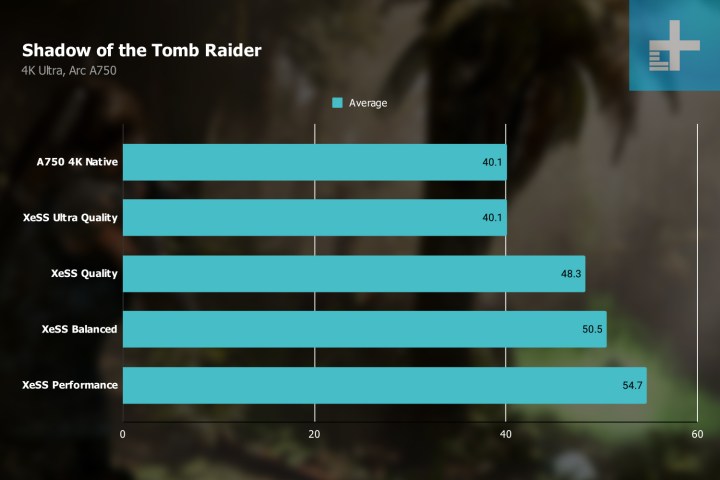Intel XeSS is an exciting development in the world of upscaling PC games. This technology is finally out, and we’ve tested it extensively to give you a full overview of how it can improve your gaming experience.
While Intel XeSS is similar to the tech we already know well from AMD and Nvidia, it comes with its own pros and cons. We’ve rounded up everything you need to know about Intel XeSS, how it works, what games it supports, and how it compares to its rivals from AMD and Nvidia.
What is Intel XeSS?

Intel XeSS, or Xe Super Sampling, is an upscaling feature of Intel Arc Alchemist graphics cards. It works by rendering your game at a lower resolution and then upscaling it using machine learning and dedicated AI hardware found inside the GPU. This helps it improve performance while maintaining as much image quality as possible.
XeSS works a lot like Nvidia’s Deep Learning Super Sampling (DLSS). The key difference is that Intel XeSS supports graphics cards from multiple vendors, while DLSS is limited to Nvidia graphics cards.
Intel was able to achieve this by offering two different versions of XeSS — one for Arc GPUs, such as the Arc A770 and the A750, and one for graphics cards made by other vendors. The version for Intel Arc is likely going to do a better job due to its advanced upscaling model; it’s also boosted by the Xe Matrix Extension (XMX) AI cores found inside Intel Arc. The XeSS that owners of AMD and Nvidia cards can try out is a little simpler, with a less robust upscaling model and DP4a instructions, which makes it inferior to Intel’s own XMX cores.

With that said, while the model used for non-Intel GPUs may be simpler, we still found that Intel XeSS provided a similar performance boost across the board. We’ll talk about it more in the Performance section down below.
In supported games, players will be able to select between four quality modes. Higher-quality modes offer better image quality at the cost of performance, while low-quality modes boost performance more but may not look as great:
| Mode | Resolution scaling factor |
| Performance | 2x |
| Balanced | 1.7x |
| Quality | 1.5x |
| Ultra quality | 1.3x |
In addition to more options, it looks like XeSS will be able to scale the input resolution even further than AMD’s FidelityFX Super Resolution (FSR). Four quality modes should give players more options, as DLSS and FSR only offer three quality modes, with some titles supporting an optional fourth.
How Intel XeSS works
XeSS isn’t too complicated to understand. Instead of running a game at native resolution (let’s say 4K), it takes a variety of inputs from the game at a lower resolution (like 1080p). Those inputs feed into the XeSS upscaling engine, which includes an AI model to enhance the upscaling. The final result, theoretically, should be an image that looks like the native resolution but with much higher performance.

For specifics, XeSS takes depth, motion, color, and lighting inputs from the game. After performing the upscaling, the final results from these inputs are stored in an internal history. That history feeds data to the next incoming frame, and the cycle continues. While that’s happening, XeSS takes the frame you see and performs temporal anti-aliasing (TAA) to clean up jagged edges. XeSS replaces traditional anti-aliasing, as it can upscale and perform anti-aliasing in the same step.
The secret sauce is machine learning. Intel Arc Alchemist graphics cards include XMX cores, which run the AI model to perform the upscaling. They’re similar to Nvidia’s Tensor cores on RTX 30-series graphics cards, and Intel says they provide the best quality with XeSS.
However, XeSS can also work without the XMX cores. Graphics cards that support DP4a instructions — useful for AI calculations — also work. We have a full list of supported GPUs below, but the latest RX 6000 graphics cards from AMD support these instructions, as do the last several generations from Nvidia. It’s safe to assume that Nvidia’s RTX 40-series and AMD RDNA 3 will also support XeSS.
Intel XeSS release date
Intel XeSS was always tied to Arc Alchemist graphics cards, and as such, it suffered numerous delays before finally making it to market.
However, now that Intel Arc is here, so is XeSS. The official release date for Intel’s flagship desktop GPU was set to October 12, 2022, and now, the feature is slowly going to expand to more games.
Intel XeSS games

Intel has only announced a few key titles that will support XeSS, though the company says it has several additional partnerships in the works. Here are the announced games that will support Intel XeSS when it releases:
- Anvil Vault Breakers
- Arcadegeddon
- CHORUS
- Call of Duty: Modern Warfare II
- Chivalry II
- Death Stranding: Director’s Cut
- DioField Chronicle
- Dolmen
- Ghostbusters Spirits Unleashed
- Ghostwire Tokyo
- Gotham Knights
- Hitman III
- Naraka: Bladepoint
- Redout 2
- Shadow of The Tomb Raider
- Super People
- The Riftbreaker
- The Settlers
- Vampire the Masquerade: Bloodhunt
Although Intel has only revealed a few titles that will support XeSS, we should see broader support in the future. Intel says it’s working with studios like Techland (Dying Light 2), 505 Games (Control, Ghostrunner), and Ubisoft to bring XeSS to more titles.
Support will be a key factor for the upscaling tech’s success. Between Nvidia DLSS and AMD FSR, a lot of games already have an upscaling feature, so XeSS is entering a crowded market.
Intel XeSS compatibility

Intel XeSS has competition from Nvidia DLSS and AMD FSR, but it looks to combine the best of both pieces of tech under a single roof. That’s because XeSS supports both Intel and third-party graphics cards, including some that are a few generations old.
Only Intel’s Arc Alchemist graphics cards will have the dedicated XMX cores, and Intel says they provide the best quality and performance. However, GPUs that support DP4a instruction can also run XeSS, just with a slight trade-off between image quality and/or performance. Here are the GPUs that support DP4a for Intel XeSS:
- Intel Arc Alchemist (Xe-HPG)
- Intel Xe-LP integrated graphics (11th-generation mobile)
- AMD RX 7000 (RDNA 3)
- AMD RX 6000 (RDNA 2)
- Nvidia RTX 40-series (Ada Lovelace)
- Nvidia RTX 30-series (Ampere)
- Nvidia RTX 20-series (Turing)
- Nvidia GTX 10-series (Pascal)
Although XeSS doesn’t have as broad compatibility as FSR, it covers a lot more ground than Nvidia DLSS — and it appears to function in the same way.
Intel is offering XeSS as an open-source package for developers, free of charge. In addition, XeSS will be offered through a plugin in Unreal Engine, making it easy for developers to implement in their games. We don’t know if XeSS will make its way to consoles like AMD FSR has yet.
Intel XeSS performance benchmarks

We had the chance to get up close and personal with Intel XeSS during our testing of the Arc A770 and the Arc A750. Here’s what we learned.
We tried XeSS both in synthetic benchmarks and in gaming scenarios. In 3DMark’s dedicated XeSS feature test, the Arc A770 and Arc A750 saw a 47% increase. In Shadow of the Tomb Raider, on an Arc A750 GPU, Intel XeSS delivered a 36.4% boost over the native 4K resolution. This was achieved in Performance mode. We’ve seen similar but even bigger gains in Hitman 3, with XeSS bringing a 42% boost. Of course, seeing as these tests were performed on Arc GPUs, the superior XMX cores were used.
We also tried the DP4a version on the RTX 3060, and surprisingly, the difference between the two was not that massive at all. The Nvidia RTX 3060 saw a 38% performance boost in Hitman 3 when XeSS was running, and Shadow of the Tomb Raider lifted that further to 44%. This spells good news for Intel, since it definitely seems that XeSS is versatile.
All in all, it seems like Intel has done well with XeSS so far. The performance gains are definitely there, and the tech is versatile enough to be supported by other GPUs. We would still like to see it available in a larger number of games, though, but that will come with time. This is just the beginning of Intel XeSS.
Intel XeSS versus Nvidia DLSS
Intel XeSS looks a lot like Nvidia DLSS, and the two upscaling features should offer similar performance. Our own tests show that Nvidia continues to reign supreme, though, but Intel Arc puts up a good fight.
Both DLSS and XeSS use AI to enhance upscaling, and they offer TAA to smooth the image after it has been upscaled. The main difference is that XeSS can run on dedicated XMX cores or on general hardware that supports DP4a instruction. DLSS can only run on dedicated Tensor cores on Nvidia 20-series, 30-series, and 40-series graphics cards.
Intel has confirmed that XeSS doesn’t require per-title training. This was a major hurdle for DLSS when it was first released, but Nvidia has since built the feature to run on a general AI model instead of a per-title one.

In terms of raw performance, comparing Intel XeSS to Nvidia DLSS shows that the latter is still better, but Intel is possibly doing a better job than AMD did with FSR. Just look at the Shadow of the Tomb Raider benchmark above — nearly all of the XeSS results are in the lower half of the ranking. XeSS Ultra Quality hit the same frames per second as native 4K, but Performance mode boosted that to 59.9. However, Nvidia DLSS wins the top three spots at 61.7, 70.1, and a whopping 87.9 in Ultra Performance mode.
Editors’ Recommendations
-
Intel Arc Alchemist: specs, pricing, release date, performance -
Intel Arc A750 vs. Nvidia RTX 3060 -
Intel Arc A770 16GB vs. A770 8GB vs. Nvidia RTX 3060 -
Best HP Envy deals for October 2022 -
This gaming chair makes your butt a part of the action

